

Vornbach Abbey (German : Kloster Vornbach, sometimes spelt Formbach) was a Benedictine monastery in Neuhaus am Inn in Bavaria, Germany.


Vornbach Abbey (German : Kloster Vornbach, sometimes spelt Formbach) was a Benedictine monastery in Neuhaus am Inn in Bavaria, Germany.
The monastery, dedicated to the Virgin Mary and Saint Benedict, was founded in 1094 by Count Ekkebert of Formbach and his wife Mathilde, and also by Count Ulrich of Windberg.
It was dissolved in 1803 during the secularisation of Bavaria. The monastic buildings came into the possession of Franz X. Bachmayr, and in 1857 into that of the Baron von Schätzler. The abbey's Austrian possessions were taken by the state. [1] [2]
Biburg Abbey was a Benedictine monastery located at Biburg in Bavaria, Germany.

Frauenzell Abbey was a Benedictine monastery situated in Frauenzell, which is part of Brennberg in Bavaria, Germany.
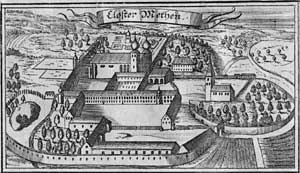
Metten Abbey, or St. Michael's Abbey at Metten is a house of the Benedictine Order in Metten near Deggendorf, situated between the fringes of the Bavarian Forest and the valley of the Danube, in Bavaria in Germany.
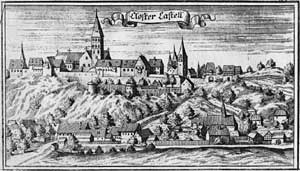
Kastl Abbey is a former Benedictine monastery in Kastl in the Upper Palatinate, Bavaria.

Scheyern Abbey, formerly also Scheyern Priory, is a house of the Benedictine Order in Scheyern in Bavaria.
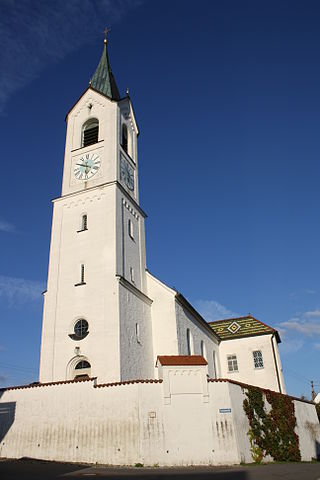
Reistingen Abbey was a house of Augustinian canonesses, previously a Benedictine monastery, at Ziertheim in Bavaria.

Rinchnach Priory was a Benedictine monastery at Rinchnach in Bavaria, Germany.

Oberalteich Abbey was a Benedictine monastery in Bogen, Bavaria, Germany.
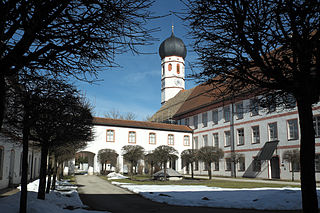
Beuerberg Abbey, formerly a monastery of the Augustinian Canons, is now the Monastery of the Visitation, Beuerberg, a community of the Visitandines in Eurasburg in Bavaria, Germany.

Theres Abbey was a Benedictine monastery in the village of Theres in the district of Hassberge, in Franconia in the north of Bavaria, Germany.
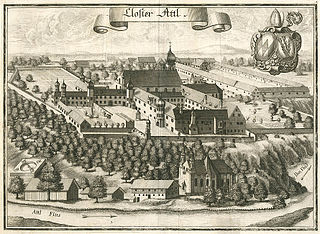
Attel Abbey, also Attl Abbey, was a Benedictine monastery, later a home for the disabled run by the Brothers Hospitallers, in the village of Attel near Wasserburg am Inn in Bavaria, Germany.

Weissenohe Abbey was a Benedictine monastery in Weissenohe in the district of Forchheim in Bavaria, Germany.
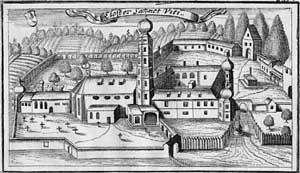
St. Vitus' Abbey, occasionally also St. Vitus' Abbey on the Rott, was a Benedictine monastery in the municipality of Neumarkt-Sankt Veit in the district of Mühldorf in Bavaria, Germany.

Wettenhausen Abbey was an Imperial Abbey of Augustinian Canons until its secularization in 1802–1803. Being one of the 40-odd self-ruling Imperial Abbeys of the Holy Roman Empire, Wettenhaussen Abbey was a virtually independent state. Its abbot had seat and voice in the Imperial Diet, where he sat on the Bench of the Prelates of Swabia. At the time of secularization, the Abbey's territory covered 56 square kilometers and it had about 5,400 subjects.

Elchingen Abbey was a Benedictine monastery in Oberelchingen in Bavaria, Germany, in the diocese of Augsburg.

Aldersbach Abbey is a former Cistercian monastery in the community of Aldersbach in the district of Passau in the valley of the Vils, Lower Bavaria, Germany.

Banz Abbey, now known as Banz Castle, is a former Benedictine monastery, since 1978 a part of the town of Bad Staffelstein north of Bamberg, Bavaria, southern Germany.
Roggenburg Abbey is a Premonstratensian canonry in Roggenburg near Neu-Ulm, Bavaria, in operation between 1126 and 1802, and again from its re-foundation in 1986. Since 1992 it has been a dependent priory of Windberg Abbey in Lower Bavaria. The monastery manages a training centre and a museum, and is widely known for its almost unchanged Baroque building and the organ concerts that are held in the church.
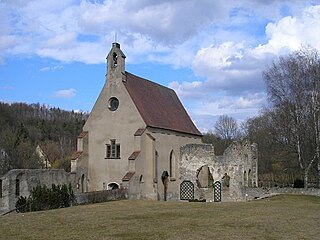
Christgarten Charterhouse is a former Carthusian monastery, or charterhouse, near Ederheim in Bavaria, Germany.

The Collegiate Church of Saints Philip and James, Altötting, with the associated college or community of secular canons, was founded in about 1228 in Altötting, Bavaria, southern Germany.
48°27′37″N13°25′36″E / 48.46028°N 13.42667°E